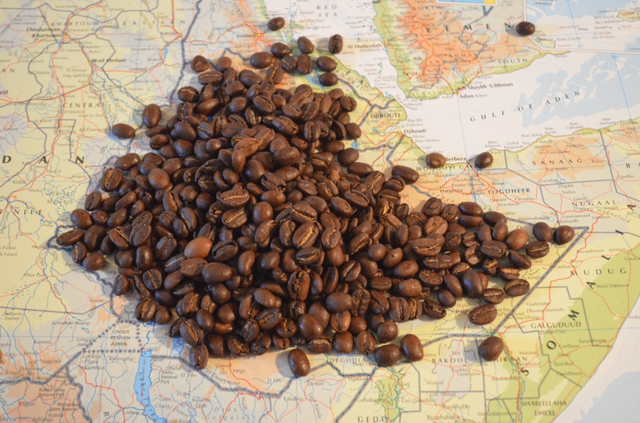History of Coffee Around the World
Coffee is amongst the most commonly drunk beverages in the world. While many of us now couldn’t bear to start our mornings without a sip of this brew, coffee was only introduced to Europe during the 1600s. We take a look at where coffee originated, and how it ended up being grown and enjoyed around the world!
Origin of Coffee
When it comes to the origin of coffee, there is no simple answer. There is great debate about whether coffee was first discovered in Ethiopia or Yemen, with both countries providing origin stories for our favourite beans.

Ethiopian Coffee Story
The coffee origin myth from Ethiopia is perhaps the more popular tale. It involves a goat farmer noticing that his goats acted energetic and excited after eating some bright red berries (coffee cherries).
The farmer gathered the berries and took them to a local monastery, where they were thrown on the fire, creating a delicious aroma. The now roasted beans were then ground up and brewed in hot water, making the first-ever cup of coffee! This is believed to have occurred during the 9th century.
Yemen
In a similar tale to the Ethiopian legend, the origin story from Yemen involves a traveller seeing birds eating berries and becoming energetic. Tired from his travels, he decided to try the berries for himself to gain an energy boost.

Which Origin Story Is Right?
While it is impossible to know for sure when coffee was first discovered and brewed, it is generally believed that coffee was originally found in Ethiopia and exported to Yemen.
Origin of Coffee vs Origin of Beans
There is also debate about what classes as the discovery of ‘coffee’. It is thought that coffee beans and coffee cherries had been used for a long time prior to the discovery of ‘coffee’ as a drink.
Historians believe that coffee beans were chewed, as well as being ground into a paste with ghee to create tasty energy balls.

Coffee and the Arabian Peninsula
After its discovery (whether that be in Ethiopia or Yemen!), coffee slowly began to be traded and cultivated on the Arabian Peninsula. By the 1500s, coffee had reached Turkey, Syria, Persia and Egypt.
Coffeehouses were opened, allowing people to drink coffee both at home and in public with friends. These coffee houses, known as qaveh khaneh, became cultural centres, with musicians and performers putting on shows for the patrons.
Coffee Introduced to Europe
Travellers visiting Arabia from Europe began to spread the word about coffee. Throughout the 17th century, the drink found its way to many European countries.

Venice
The trade links between Venice, North Africa and the East, saw a wealth of products, including coffee introduced to mainland Europe during the 17th century. The drink was first sold to wealthy Venetians, before the first coffeehouses were established in 1645.
France
Coffee arrived in France in 1644 at the port of Marseilles. The first coffeehouses were opened in Marseilles in 1671 and largely catered to travellers and merchants.
It wasn’t until 1669 that coffee reached Paris. It was introduced by Suleyman Aga, who was sent to the court of King Louis XIV as an ambassador by Sultan Mehmet IV. Paris’ oldest coffeehouse, Café Procope, was opened in 1686, and you can still visit it today!
Austria
After the Battle of Vienna ended in 1683, a number of sacks of coffee were left behind in Austria by the Turks. Polish military officer, Jerzy Kulczycki, knew of coffee as a beverage from his time in Turkey.
He opened a coffeehouse using the coffee left behind, thus introducing Austria to coffee. Kulczycki was also responsible for popularising adding milk and sugar to coffee.
UK
The first coffeehouse in England was opened in Oxford in 1651, by Pasqua Rosee, who opened the first coffee shop in London a year later. Rosee was the servant of Daniel Edwards, a trader in Turkish goods, who imported coffee to the UK. By the mid-1600s, there were over 300 coffee shops in London, with 3,000 coffeehouses across England by 1675!
Penny Universities
By 1660, coffeehouses had become an integral part of social culture in London. They were dubbed ‘Penny Universities’, as they were typically frequented by artists, writers, philosophers, politicians and lawyers. It cost one penny to enter the coffeehouse, where you could enjoy stimulating conversation along with a great brew!

Introducing Coffee to the New World
Coffee was introduced to North America during the mid-1600s by the British. While a few coffeehouses were opened in New York (then New Amsterdam), tea was widely preferred.
However, this changed with the events known as the Boston Tea Party in 1773, when colonists revolted against the taxes imposed by King George III. After that, coffee became the drink of choice for many Americans.
Establishing Plantations Around the World
With coffee introduced to much of the world, the demand for coffee beans grew, along with the need for coffee to be cultivated in other parts of the world.
Towards the end of the 1600s, the Dutch took seedlings to grow on the island of Java in Indonesia. Following the success of these crops, the cultivation of coffee was expanded to the islands of Sumatra and Celebes.

Coffee Growing in South America
In 1723, naval officer Gabriel de Clieu took a seedling of a coffee plant in the Royal Botanical Garden in Paris overseas to Martinique, a Caribbean island.
That one seedling is responsible for the spread of around 18 million coffee trees on the island, as well as being the parent plant for coffee trees growing in the Caribbean, Central and South America!
Brazilian Coffee
Brazil is now the biggest producer of coffee in the world and has held that title since 1852. Brazilian coffee came to be thanks to Francisco de Melo Palheta, who was sent to get coffee seedlings from French Guiana.
While the Governor of French Guiana refused to hand over any seeds, Palheta was able to seduce his wife, who gifted him a bouquet of flowers with coffee seeds hidden within!

Coffee in Asia
Coffee has long been both enjoyed and grown in countries throughout Asia. Some coffee was introduced by those travelling from Ethiopia and the Arabian Peninsula, whereas other countries, particularly islands, were introduced to coffee by colonisers.
India
Coffee was introduced to India by those travelling from Ethiopia and Arabia. Beans were first grown in 1670 in Chikmagalur in Karnataka where plantations are still established today. Karnataka accounts for 53% of the coffee production in India.
Philippines
In 1740, a coffee tree was introduced to the Philippines by a Spanish Franciscan friar. Coffee plantations were established throughout the province of Batangas, and by the 1860s, the Philippines were exporting coffee to America and Europe.
Unfortunately, in 1889, coffee rust and insect infestations destroyed most of the coffee trees, halting the production. By the 1950s, a more resistant variety of coffee plant had been introduced, and coffee production in the Philippines soared again.
Vietnam
Vietnam is now the second-biggest producer of coffee in the world, despite being introduced to coffee later than many other locations. Coffee was first introduced in 1857 by the French.
Production was ramped-up in the 1920s with plantations established in the Central Highlands. Robusta coffee now amounts for 97% of the total output from Vietnam.

Now, coffee is enjoyed worldwide, and each of these countries has created its own signature style of preparing the beverage; some of which are a bit weird and wonderful! To find out why coffee grows so well in the places the coffee seedlings were taken, take a look at our guide to the coffee bean belt.
Are you planning to visit any of these countries soon? Make sure you take a travel coffee maker with you!


3 Comments
Thanks for the sharing- much appreciated
https://shop.campinggears.ph/products/aeropress
We had a coffee farm in Tanzania which is now producing tea. The Usambaras coffee was good. I remember picking the berries and chewing them. I know coffee grows well on the slopes of Kilamanjaro and Mount Kenya. It likes the volcanic soil
I like coffee